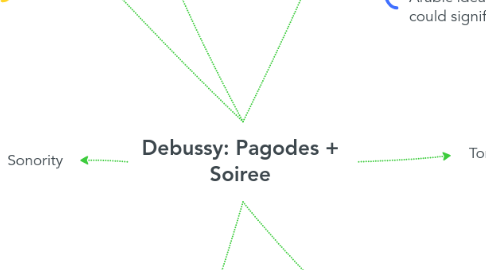
1. Structure
1.1. A succession of different themes (Theme at 41 returns at 97) - some repetition
1.2. Ternary Form with Coda
1.3. Arabic idea returning at the end could signify a ternary form
2. Tonality
2.1. Static Harmonies - Remains close to B Major Bars 33 - 53: F#/D# Major Region
2.2. Keys related to F# Major: Reinforced with pedals Whole tone weakens tonality
2.3. Interruptions in triple time are modal: C Mixolydian (109) A Mixolydian (115)
3. Sonority
3.1. Both pieces explore full range of piano
3.1.1. Pagodes: B -> A# Soiree: C# -> C#
3.2. "Washes" of sound: "Blurring the edges": use of sustain pedal
4. Texture
4.1. Pagodes
4.1.1. Layered homophony
4.1.2. MDH
4.1.3. Drone
4.2. Soiree
4.2.1. Draws on varying types of homophony
4.2.2. Monophonic, Chordal, MDH
4.2.3. 3 part texture - Habanera, melody and chords
5. Tempo, Metre + Rhythm
5.1. Pagodes
5.1.1. Moderately quickly/animated
5.1.2. Use of ritardando
5.1.3. Use of 4/4 - 2 bars of 2/4
5.1.4. Triplets + Quintuplets
5.2. Soiree
5.2.1. Habanera Rhythm
5.2.2. Duple time (2/4) - some triple time (3/4
5.2.3. Triplets, Syncopation, Cross Rhythms and Reverse Dotted Rhythms
6. Harmony
6.1. Pagodes
6.1.1. Static Quality
6.1.2. Pentatonic scales impacts harmonic chords
6.1.3. Added 6th chord at start
6.2. Soiree
6.2.1. Parallel 7th chords - Bar 17 Whole tone harmonics - Bar 23 Open 5th chords - Bar 38
7. Melody
7.1. Pagodes
7.1.1. 2 bar phrases
7.1.2. Pentatonic structures
7.1.3. Pentatonic Scale: G#, C#, D#, F#, B (accompaniment)
7.2. Soiree
7.2.1. Bar 7: Moorish melody
7.2.2. Bar 23: Whole tone + heavy syncopation
7.2.3. Bar 17: Balanced 2 bar phrases
7.2.4. Bar 41: Major key
